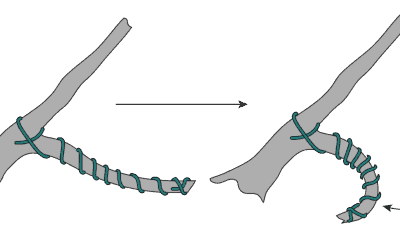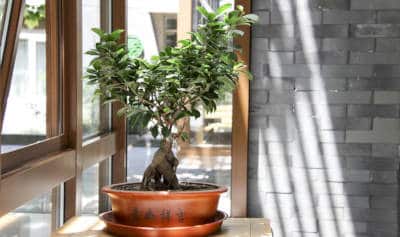How Do You Trim the Roots of a Bonsai Tree?

I’m starting to get more comfortable with pruning the branches of my bonsai trees to develop and maintain their shape. I’m not so sure about how to go about pruning the roots though, so I wanted to find out more about this.
How do you trim the roots of a bonsai tree? To produce a miniature tree that looks like a full-sized tree that’s being viewed from a distance you need to prune its roots. If you are cultivating your tree from seed or sapling you will need to prune the main root quite severely early on. You need to prune the overgrowing roots of an established bonsai tree to keep it small and compact.
Pruning the roots is a bit different to pruning the tree branches – the results are happening underground, but the effects will be seen above ground. There’s quite a lot to consider when pruning the roots of your bonsai tree.
Why Do You Prune the Roots?
One of the main aims of bonsai is to produce a miniature tree that looks like a full-sized tree that’s being viewed from a distance.
This wouldn’t be very successful if all you did was prune and shape the trunk and branches. You need to apply some restriction to the overall growth of the tree, and you can do this by pruning and restricting the growth of the roots.
When Do You Start Pruning the Roots?
If you are cultivating your bonsai tree from seed, seedlings, or very small tree, then you will need to prune the roots quite severely the first time you do it.
When the plant, or tree, is still quite small you need to cut the tap root about a quarter to a third of the way down from the shoot. If you are growing from seed you should do this when the plant starts to develop a woody thickening in the stem, and has foliage growing at the top.
In this initial pruning of the roots you will have to cut the taproot. The tap root is the main, cone-shaped, root that grows downwards. It’s the main part of the root that the smaller root branches grow out from.
To prune the roots like this you will need to remove the plant from the pot and brush away the soil to expose the roots. The root will be quite narrow at this stage, so cutting it should be easy.
This pruning of the taproot is necessary for a couple of reasons:
Firstly, you need to reduce the size of the roots to apply some “stress” to the tree, to restrict its growth, so that it develops into a bonsai. The pruning probably does this by impeding the ability of the roots to absorb water and nutrients, which will limit the amounts available to the developing tree.
Secondly, you are likely to be repotting your tree in a shallow pot, so you need the root system to be shallow rather than deep. Removing two thirds to three quarters of the taproot produces lateral growth of the roots, just like removing the tip of a growing shoot above ground results in more lateral branches.
The tree should then be repotted carefully in a small pot with some potting compost. Care needs to be taken at this stage since one of the plant’s “major organs” has been removed, so careful potting with appropriate soil moisture and nutrients is important.
Watch out for Root Circling
Once the tree has had an opportunity to grow for a few weeks you should lift the tree, and the soil around the roots, out of the pot to check the roots. Apparently, what you are looking for is called “circling” of the roots.
Circling is where the tap root has continued to grow in a circle around the inside of the pot. I’m still researching why this is such a bad thing, but it seems that it’s more desirable to have a fibrous network of fine roots rather than this circling tap root.
It may be that having the tap root remaining (we looked at cutting most of it off earlier) doesn’t produce the stress on the tree that’s needed for restricted growth in bonsai trees.
One way to avoid root circling seems to be using the right pot design. Apparently, poor soil drainage and aeration can can contribute to root circling. Pots with a large meshwork area on the bottom for drainage can help with this.
Another type of pot that I’ve seen, which is supposed to help with proper bonsai root growth is one with multiple perforations. These pots have numerous perforations all way around the walls of the pot, together with multiple perforations in the bottom of the pot.
These numerous perforations help to ensure thorough drainage from all parts of the soil inside the pot, which avoids parts of it becoming waterlogged.
The perforations also cause the roots to come into contact with the air around and beneath the pot. Root tips coming into contact with the air causes the tip to dehydrate, which stops them growing. This is called air pruning.
Air pruning seems to be an accepted technique for keeping plants roots healthy in general, helping to avoid root circling and tangled roots. Now I want to find out more about how air pruning can be used as a specific bonsai technique.
My dad used to grow bonsai seedlings in half-grapefruit skins (after the fruit had been eaten and the skin was empty). He told me that this was to let the roots grow through holes he had made in the skin. I guess he must have been pruning the roots as they grew through, or was using the skins to enable air-pruning.
Maintenance Pruning
Maintenance pruning of the roots is necessary to keep the tree compact and small. If you allow the roots to grow in an uncontrolled way, then this can lead to the tree starting to grow bigger. This is usually not desirable in a bonsai tree.
Start by lifting the tree, and the soil around the roots, out of the pot. The soil around the roots can removed with your fingers initially, and the individual roots can be teased out with root hooks.
Any straggly roots can be trimmed with general purpose shears, and root shears for any thicker roots. Guidelines I have seen suggest that you trim the roots to the width (distance from the trunk) of the larger established roots that are often visible above the soil.
After the roots have been pruned the tree can be repotted in an appropriate bonsai potting mix.
This process is often called repotting, which suggests you repot the tree in a new, maybe bigger, pot. Often the tree is repotted back in the pot it was in before, and it was only removed for root maintenance.
The best time for maintenance root pruning on an established bonsai tree seems to be when the tree is being repotted.
When to Prune Your Bonsai Tree Roots
The advice on what time of year to prune the roots of your bonsai tree, and repot it afterwards, seems to vary a little
Some experts say that the best time to do this is during the winter when the tree is dormant due to cold weather and short day length. Others suggest the best time to do this is just before the tree wakes up again, just before winter moves into spring.
This time just before the spring makes sense to me. Root pruning represents and injury to the roots and I think it may help the tree to recover if this happens fairly close to the start of the growing season.
Bonsai Tools for Pruning the Roots
There is large variety of bonsai tools available, and the options can be quite confusing.
The roots in a very young tree are still quite narrow and can be cut fairly easily. When pruning these very young roots all that is needed is a pair of general purpose bonsai shears.
In more established bonsai trees the roots can be more difficult to cut. Tree roots undergo a type of secondary thickening that is similar to the thickening that causes the branches and trunk of trees to become woody. This means that more specialised root pruning tools can be needed.
There are a couple of options for cutting these thicker roots.
The first is a pair of root (and branch) shears. The handle of these shears is usually quite a bit longer than the blades, which gives you more leverage when cutting thick roots.
Another option is a pair of root cutters. This tool looks a bit like the pliers that are used to pull nails our of wood. The blades on root cutters don’t cross each other the way that the blades in shears do.
The jaws of root cutters apply more of a “pinch cut”, and the long handles and short jaws provide a lot of leverage for cutting thick roots.
Whichever tool you use to prune your tree roots, the important this is to achieve a clean cut. The danger is that the roots get squashed and the two sections are dragged apart rather than cut. A messy cut like this can make it difficult for the cut to heal.
Cuts to the roots that take a long time to heal can expose the roots, and the rest of the tree, to various types of infection. There are many micro-organisms, like bacteria and fungi in soil, and messy cuts can give them a way to bypass the plants external protective barriers.
This risk of infection is something to remember, whatever tools you decide to use for root pruning.
You can see the range of tools used to prune bonsai tree roots in the example below:







